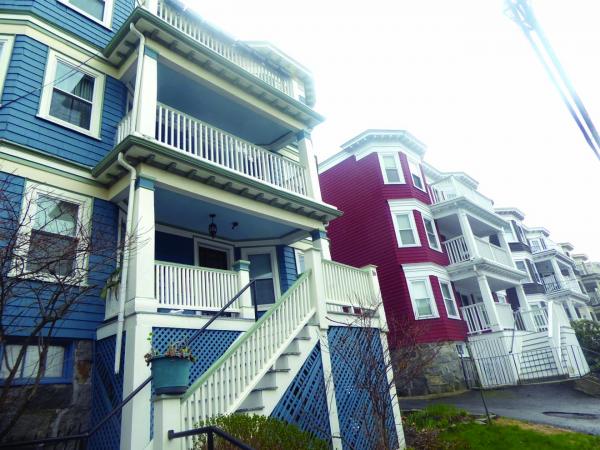June 4, 2020

Three-deckers show off their style on Thelma Road. Bill Forry photo
About a month into law school, my property law classmates had a pretty clear sense of two of my priorities: I’m obsessed with three-decker houses and I’m the resident Dorchester booster.
Two years ago, I sat in a crowded All Saints Parish church and listened to housing experts, city and state elected officials, and historians talk about three-deckers for the better part of a warm May day. Frankly, I would go to a conference on the topic every week if it were an option. My significant other and another good friend independently gave me the same adorable three-decker pin as a gift. The brand, as they say, is strong.
It seems a bit strange to me sometimes that I, a native Californian, am so fascinated by the housing style. The columns! The accent trim! The three decks!
I live in one, and strolling past neat rows of the tiered buildings in any neighborhood makes me feel like I’m heading home.
Fun fact: Our downstairs neighbors informed us that our three-decker is shown in the background in Martin Scorsese’s film “The Departed” – while Leo does his best impression of a criminal from Southie.
I’ve been singing the praises of three-deckers for almost six years. So for this Dorchester Day, I salute the adaptable and ubiquitous Boston three-decker with three reflections on the housing style and my relationship to it:
(1) When I moved from South Boston to Savin Hill and into my middle-floor apartment at the corner of two quiet one-ways off of Dot Ave, my co-workers at the Reporter all regaled me with their three-decker backgrounds. For them, these earlier residences live in their minds as packed to the porches with siblings or as a couple’s first home together.
They told me that the long layout was incredible on a warm breezy day, when opening all the windows let air flow straight through the home from front to back. Curtains or blinds across the back deck would make the porch feel like an outdoor oasis, and they could be pulled aside for some classic neighborly chatter across the shared backyard.
I was, in turn, praised for selecting the classic Dorchester residence and also mocked for laying claim to too much space for one journalist who rejects both pets and roommates; now the second bedroom is a study filled with history books, so there! But that speaks to both the function and the form of three-deckers: as apartments and condominiums, they are size-efficient and suited for residents at varying stages of their lives. My building has housed single professionals, long-time roommates, committed partners, married couples, and growing families. It is a small, rotating neighborhood under one roof.
(2) A guest speaker in one of my first-year courses (giving an otherwise very helpful presentation on increasing access to legal housing supports) referenced recent rezoning in his home neighborhood that would allow three-deckers to be built alongside the statuesque Victorian houses that drew him to the block to begin with.
He was unhappy about this, and his description of the housing as unattractive multi-family structures ruining the aesthetics of the street echoed the language used to malign three-deckers when they were essential first homes and owner-occupied investment properties for immigrant families in New England.
The neighborhoods with the highest concentrations of three-deckers are East Boston, Roxbury, and Dorchester. Their style typically allowed an owner to live in one unit and rent out the other two, or to designate units to generations of the owner’s family. Anti-immigrant sentiment led to a fallacious negative association with the three-decker style as unsafe or cheap, and zoning prohibited their construction in downtown Boston.
So, the ownership that some neighborhoods take over the wood-framed, three-story style comes with a warranted historical defensiveness.
(3) I would be remiss if I didn’t reflect on the saga of an infamous Dorchester three-decker. For more than 15 years, the house at 97 Mt. Ida Rd. was a blighted shell overlooking picturesque hilltop Ronan Park with a view of the harbor. This house was one of my introductions to persistent problem properties and its legal saga formed no small part of my fascination with property law.
Once a neighborhood eyesore, the burned-out house was filled with cat food and its interior was so unsafe that inspectors would no longer go inside. Its owner meticulously tied up all efforts to demolish the house by filing suits from Housing Court to Superior Court, even trying his luck with the Supreme Court, to no avail.
As I prepared to leave the Reporter, the court placed the Mt. Ida Road property into receivership and approved its sale in mid-2019 for $665,000. It was converted into condos and they were sold off one by one as 2019 closed, for $590,000, $615,000, and $649,000.
So, from my three-decker, I wish you a happy Dot Day. PS: This is my chance to plug my articles from 2018 on the history of the three-decker; on why, until a political rebranding, the term “triple decker” in New England only described a sandwich; and on how the housing style could adapt for our current housing crunch to accommodate more residents through modifications like accessory dwelling units and partitioning.
You can also search the dotnews.com archives and see how many times I can squeeze the words “three-decker” into a single piece.
Jennifer Smith, a former Reporter news editor, now attends Northeastern University School of Law.
Tags:



